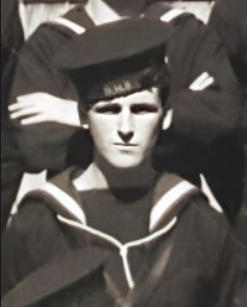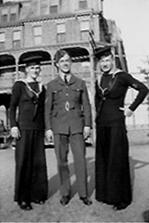Remembering the Telegraphist Air Gunners


copyright © Wartime Heritage Association
Website hosting courtesy of Register.com - a web.com company
Wartime Heritage
ASSOCIATION
Remembering Dennis Arthur Keys
Telegraphist Air Gunner
Service Number:
P/JX.518452
Service:
Fleet Air Arm Royal Navy
Dennis Arthur Keys was born on December 19, 1924, the son of Joseph Edward
and Jessie Eady Keys of Essex, England.
At HMS Saint Vincent, Dennis joined Telegraphist Air Gunner Course 55. Because
of the difficulties of training, particularly the air component of training in a war
zone, No. 1 Air Gunners School at East Camp, Yarmouth, Nova Scotia in Canada
was established under the Commonwealth Air Training Plan.
The decision to send a recruit to Yarmouth was based upon the selection
board’s belief that the recruit would be 100% successful in their training. The selection board did not want to send
anyone to Canada if they thought the recruit might have to send them back to the UK because they failed training
courses.
Dennis was one of the Telegraphist Air Gunners assigned to Yarmouth, NS Canada (RCAF Station Yarmouth; East Camp -
Fleet Air Arm Royal Navy #1 Telegraphist Air Gunner/Naval Air Gunners School) His Service Record shows:
October 12, 1943
Start of Course 55A Course (Course Photo 55A)
January 14, 1944
55A Canada - Exam for Part I of the TAG Course)
May 19, 1944
55A Canada - Exam for Part II of the Tag Course)
June 26, 1944
Royal Navy TAG. School, Yarmouth, N.S, rated TAG 3rd Class
Yarmouth tried to be a welcoming community to the TAG trainees at East Camp. During the
war, Yarmouth was the site of a large Canadian Army Basic Training Centre, as well as RCAF
Station Yarmouth that housed the RCAF at West Camp and the Fleet Air Arm Royal Navy
Training School at East Camp.
Dennis made many friends, attended the local dances, and travelled to Shag Harbor in
Shelburne Co., a small fishing community, and to Liverpool in Queens Co. on the South Shore of
Nova Scotia. He travelled to Digby, another town on the North Shore of Nova Scotia. All of
these places Dennis would have seen from the air during his training in Ansons and Swordfish
aircraft.
With the completion of his TAG Course, Dennis Keys returned to England and was assigned for
further training:
In December, 1944 Dennis Keys was stationed at RNAS Ronaldsway, and between December 16,
1944 and February 16, 1945 completed a Torpedo Bomber Reconnaissance Course (TBR).
RNAS Ronaldsway was one of the Royal Navy’s main bases for training aircrew in dropping
bombs and torpedoes on enemy vessels during the final years of the Second World War.
His next assignment was between February 22, 1945 and April 29, 1945. Posted to HMS Shripe (Squadron 744) he
completed a Conversion and A/C Course. This was at RNAS Maydown.
Maydown airfield (RAF Maydown, also known as RNAS Maydown, HMS Shrike, HMS Gannet II, or 17SLG) was an airfield
95 kilometers northwest of Belfast. Here there was an Anti-Submarine Tactical School, situated near Londonderry on
the North coast of Northern Ireland.
Between April 30, 1945 and May 23, 1945 Dennis Keys was at HMS Shrike with Squadron 836. His record indicates that
this was for additional training.
Squadron 836 was the largest squadron in the Royal Navy – probably in any navy at any time. It was made up of 23
flights of 3 or 4 Swordfish in each. It operated in 17 Merchant Aircraft Carriers or ‘MAC ships’ as they were known,
including 6 grain ships and 11 tankers, together with a Royal Netherlands Navy squadron (860) who operated from 2
tankers. These MAC ships were slightly shorter than and much narrower than the usual Escort Carriers. They were
also only able to make 12½ knots at top speed compared with the escort carriers’ 18 knots, thus making take-offs in
particular somewhat dicey in low winds. MAC ships carried almost full cargoes as well as the aircraft.
Dennis Keys then returned to the Isle of Man. His next raining period was between July 7, 1945 and September 28,
1945 at HMS Urley with Squadron 713 to complete Part III TBR course.
Upon completion of this training period Dennis Keys next assignment is unclear. The only reference in the available
records shows the date of his Discharge.
However, a December 1945 Christmas Card from Halesworth Chief
and Petty Officer’s Mess indicates that he was at RNAS Hatston,
also called HMS Sparrowhawk.
This was a Royal Naval Air Station, one mile to the north west of
Kirkwall on the island of Mainland, Orkney, Scotland. It was
located near the strategically vital naval base of Scapa Flow.
Hatston's main period of activity came during the World War II,
when it was host to a number of different types of aircraft of the
Fleet Air Arm. Over 200 naval squadrons spent time at Hatston
during the second world war, including 771, 800, 801, 804, 880,
1771 and 1820.
A Petty Officer by rank, Dennis Keys likely served in Swordfish flights as a Telegraphist Air Gunner during this period.
He was discharged from Service in August, 1946.








- World War I - Menu
- WWI Stories and Articles
- Photos - Yarmouth Soldiers
- Selection of World War I Songs
- WWI Casualties of Yarmouth, NS
- Those Who Served - Yarmouth, NS
- WWI Casualties Digby Co. NS
- WWI Casualties Shelburne Co. NS
- Merchant Mariners (1915) Yarmouth, NS
- Canadian Forestry Corps - Non Yarmouth Birth/Residence Enlistments
- US Draft Registry - Yarmouth NS Born


- World War II - Menu
- WWII Stories and Articles
- Telegraphist Air Gunners
- WWII Casualties of Nova Scotia
- US Casualties with NS Connection
- Far East/Pacific Casualties with NS Connection
- Merchant Navy Casualties Nova Scotia
- Nova Scotia WWII Casualties Holten Canadian War Cemetery
- D-Day Casualties - Nova Scotia
- CANLOAN Program Casualties - Nova Scotia
- Battle of the Bulge Casualties - Nova Scotia
- WWII Casualties Yarmouth NS
- Yarmouth Casualties - RCAF RAF Canadian Army WWII
- Yarmouth Co., Marrages WWII
- Casualties Non-Born/Residents with Connection to Yarmouth Co., Nova Scotia.
- WWII Casualties Digby Co., NS
- Non-Nova Scotian WWII Casualties Buried in Nova Scotia
- WWII RCAF Casualties Aged 16-18
- Brothers/Sisters Who Served - World War II













